Chris & Allyson vs. Europe (2017)
Budapest Day Two: Castle Hill and the Funicular. Matyas Church and Fisherman's Bastion. Hospital in the Rock. National Gallery. Budapest Eye.
The week before we went to Budapest, we were anxious about the weather. One website said it would be raining, another said it would be sunny. Plus, we didn't know how Budapest weather works. If you look at a 10-day forecast for Hawaii, it says rain every day -- but it rains for 15 minutes, then stops. Is Budapest the Hawaii of Eastern Europe? And if so, can I wear I Hawaiian shirt there, with pride? Because we weren't sure about the rain, we left the itinerary for our second day open. And it turned out to be gorgeous.
Don't worry. Be happy.
With blue skies above, it was a great day to check out Castle Hill. Many centuries ago, nomadic horsemen decided that the hill on the west bank of the Danube would be a great spot for lording over peons. From that spot, you can see for miles on a clear day,, you "command" the river, and anyone trying to kill you has to walk uphill, which is a great deterrent.
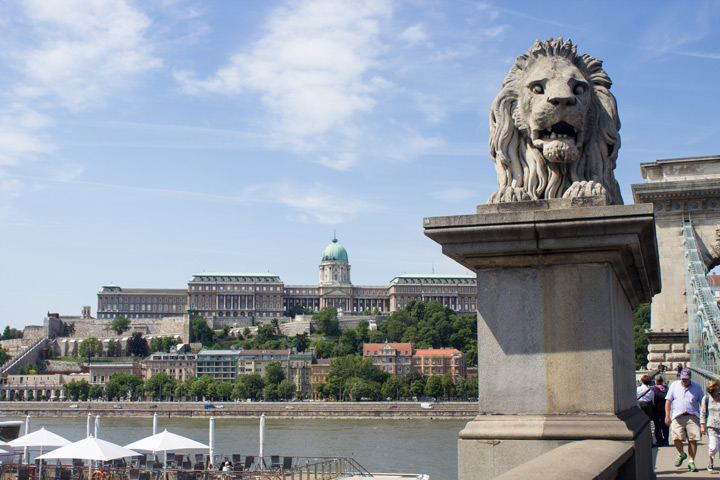
Ready to cross Chain Bridge.
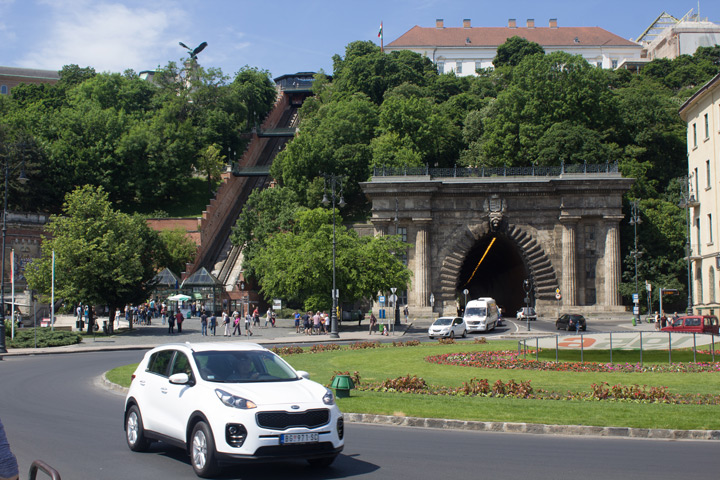
On the "Buda" side of the river, a view of the Castle Hill Funicular.
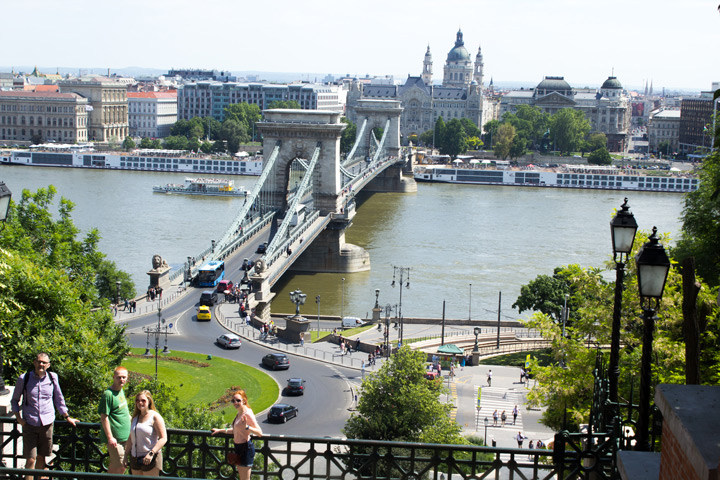
Looking back toward Pest from the Castle Hill Funicular.
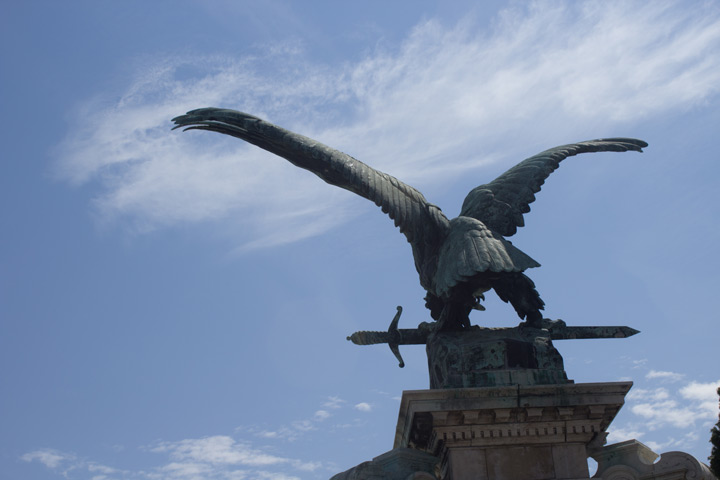
One of the statues overlooking the river from the top of Castle Hill.
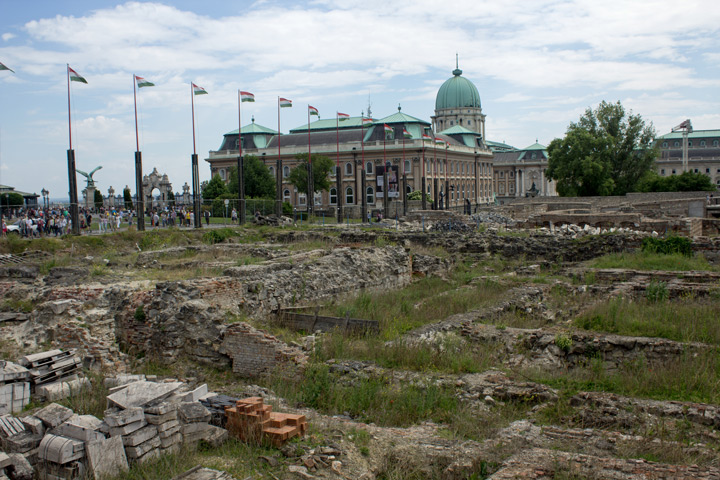
Just across this archaeology site you can see the palace complex.
After a disturbingly complete breakfast at the Bohem hotel, we walked north along the river, then crossed the Danube on the historic Chain Bridge. We were now in Buda, at the foot of Castle Hill. You can walk up the hill if you want – it's not that far. But the touristy (i.e. lazy) way up is the funicular at the end of the bridge. We got in line with the other tourists, and that's when a man with a yellow umbrella approached us. Amazingly enough, it was not the start of a Soviet Bloc espionage caper. The man surmised that we spoke English, and he told us that his friend was giving a free walking tour of Castle Hill in a few minutes. All we had to do was look for another guy with a yellow umbrella at the top.
The beauty of an unscheduled day is that you can spontaneously risk getting abducted by a Hungarian human trafficking syndicate. There were enough witnesses around that it all seemed safe, so we rolled the dice. Our faith in humanity was greatly rewarded. It was a great tour.
"Andrew" (his Anglicized name) was an engaging guide, with a clear love of architecture and history. After studying hotel and restaurant management at school, he decided to blow it all up and start a tip-based tour company with his friends. He fielded questions like a champ, offered a little humor and gave a great introduction to the giant mess that is Hungarian national identity. Some quick highlights:
The Magyars, a bunch of wandering people from the Ural Mountains, made their way to the region and decided to settle down in the late 9th century. Their leader was Arpad, who united seven Magyar tribes. St. Steven (who was just Steven at the time) showed up in the late 10th century, converted all the Magyars to Christianity, and became the first king. At some point the Mongols invaded, overran the city, then retreated thanks to some internal political problems. The Ottomans put the region under Muslim rule for 160 years, starting in 1541. Meanwhile, the Habsburgs were lurking to the west. They eventually muscled out the Ottomans and imported a bunch of Germanic settlers. In the middle of the 19th century, Hungary was elevated to co-headliner status by the Habsburg rulers, becoming half of the Austro-Hungarian Empire. Unfortunately, the Hungarians were on the losing side of World War I, and the Habsburgs were kicked into the dustbin of history. Lots of Hungarian territory was spun off to other countries. During World War II, Hungarians hoped to restore their past glory, but they picked the wrong horse to back: like all the Axis powers, they were squashed. And afterward, the Soviets took over, instituting a four-decade reign of terror, highlighted by one disastrous attempt at rebellion in the 1950s. Ever since the collapse of communism, Hungary has been doing its best to become a run-of-the-mill Western democracy.
That's a lot of drama for one millennium, and Castle Hill was the setting for plenty of great scenes. It was an excellent spot for a defensive structure, and a showy spot to build a church. The Habsburgs kept their palace there, and the hill is also riddled with natural caves -- so it became a convenient bomb shelter for the air raids of the 20th century. The upshot is that nothing on Castle Hill is 100 percent original. Buildings were built, repurposed, partially destroyed, rebuilt, expanded, partially destroyed again, given new coats of paint, buried, unburied, burned, patched up, abandoned, rediscovered and cleaned up. (Andrew's guess was that Budapest had been razed four times over the last 1,000 years.) Most of the "castle" complex – the old Habsburg Palace and environs – has been restored to its 1940s appearance, before the Americans and British bombed the crap out of everything.
All this speaks to Hungarian national identity in 2017. They're clearly proud of their heritage, but it includes a lot of losing, and recent generations have clear memories of being under the thumb of the Soviets. So they're kind of mopey.
Andrew shared this info while walking along the scenic side of the palace, with views of Pest and the river below. Then we did an about-face and made our way a few blocks to Matyas Church, a pretty structure ordered up by St. Istvan a thousand years ago. (It should be noted that we stopped en route at the equestrian statue of a military hero, and Allyson observed the local custom by touching the horse's balls for luck. It's an important memory that we can't allow to fade.)
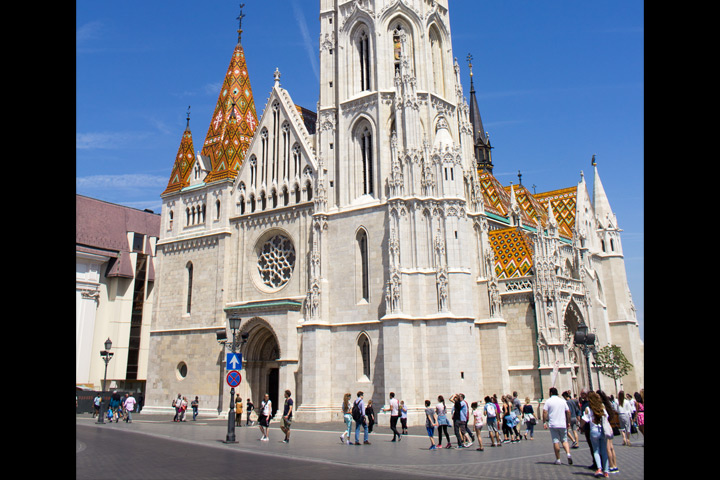
Matyas Church, one of Budapest's most historic houses of worship.
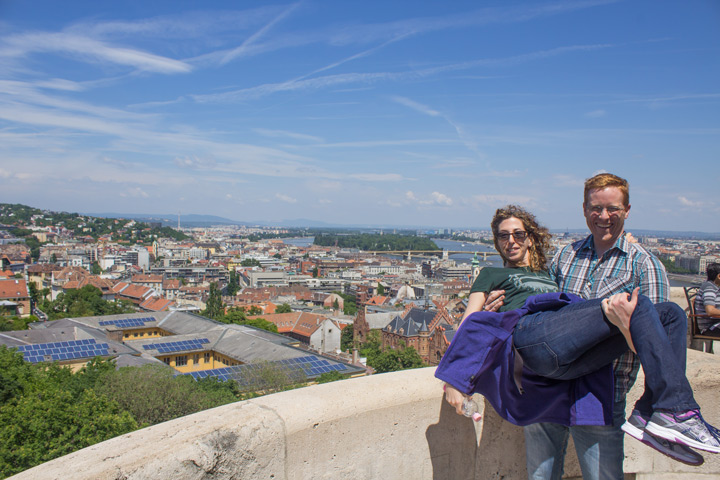
The view from Fisherman's Bastion.
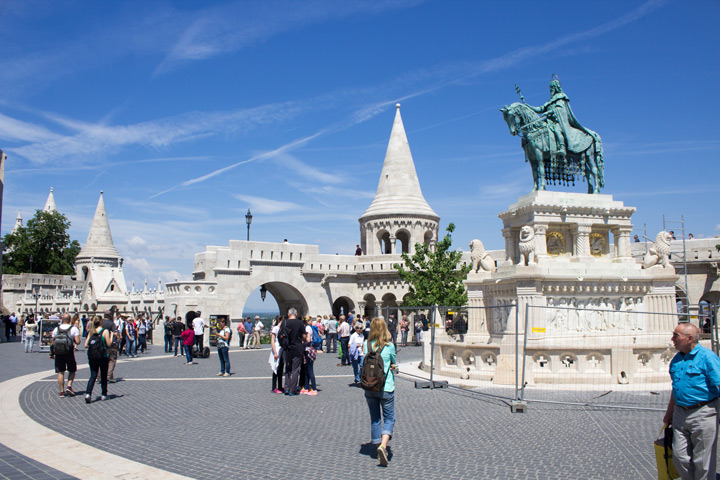
The plaza by Matyas Church and Fisherman's Bastion.

One of the beautiful windows inside Matyas Church.
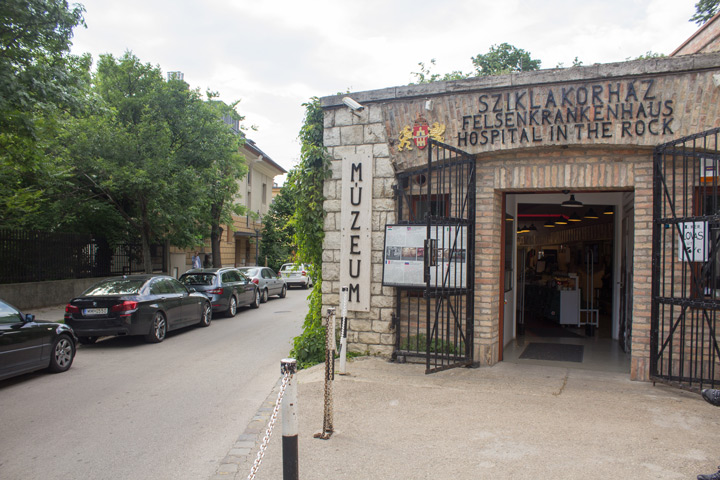
The exterior of the bomb shelter / hospital museum. (No pictures inside.)

Allyson gloats after her clear victory in an archery contest.
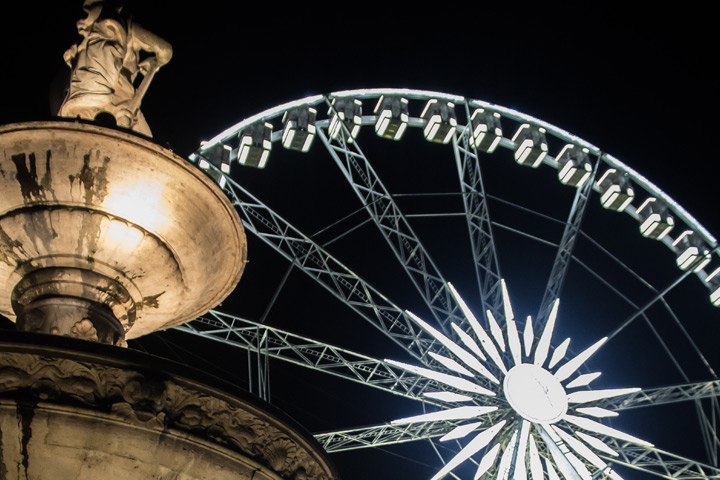
Ferris wheel rides are mandatory. Budapest Eye.
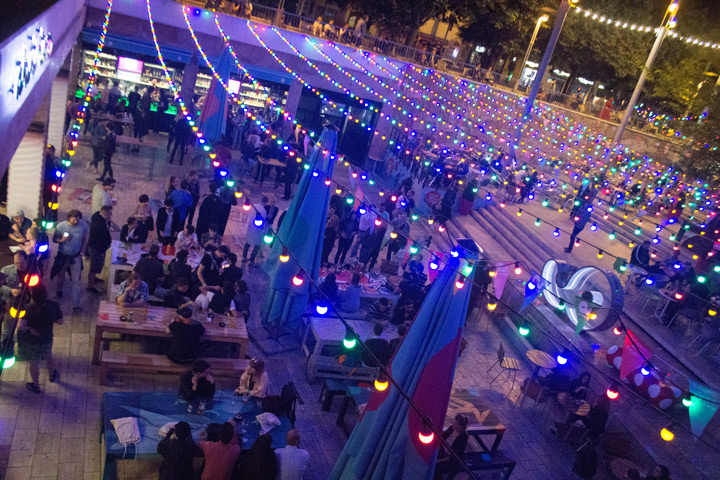
Nightlife at Erzsebet Square.
But back to Matyas Church, which is a perfect illustration of Budapest's story arc. It was built by St. Istvan; it was converted to a mosque by the Ottomans; and it eventually hosted the coronation of the Habsburg monarchs. It doesn't have a single architectural style, because each time it was expanded or renovated it incorporated elements from that time period and the people in charge.
Matyas Church is next to Fisherman's Bastion, a purely symbolic structure put up around the time of Hungary's millennial celebration in the 1890s. (There are seven mini-towers, representing the tents of the seven Magyar tribal leaders.) It looks like something a cartoon princess should sing on. Somehow this all blends together into one seamless plaza.
We poked our noses in the church before having lunch at a nearby café. Then we walked a few blocks to pop into the Hospital in the Rock. The name says it all: It's a hospital, built in the natural caves inside Castle Hill. During the World War II air raids, it was a facility to treat the injured and house the air raid warning system. It's an absorbing tour, and for about 20 minutes we even forgot that the noble Hungarians were being bombed because (oh yeah) they sided with Hitler. The Soviets expanded the facility to serve as a nuclear bomb shelter, and anti-Soviet rebels used it as a base during their spectacularly failed revolution in 1956.
A few other memories jump out. Just outside the palace, we stumbled across a Ren-fest-style archery game, where you get five shots for a few bucks. Of the two of us, Allyson was the only one to hit the target. The palace now houses Hungary's national gallery, so we used our tourist "Budapest cards" to get free admission and check out some of the finest examples of Hungarian art. We figured out quickly that Hungarians have earned their reputation for not being world-class artists. But there was another great view of the city from the cupola at the top of the museum. And we closed out our day with some sweets at what is allegedly the oldest café in the neighborhood. (Open since 1827, if you're keeping score.)
It was a long day in the sun, so we took a tram back to the hotel and chilled out. The only agenda item left for the day was dinner. We set out on foot hoping to find Café Kor – an "authentic" joint recommended to us the night before, by our dining companions from New York. We had the name of the restaurant and the address; we had a functioning knowledge of the neighborhood; and we had no success finding the restaurant. At all. Either I memorized the wrong address, or Café Kor is the restaurant version of Brigadoon. The search kept going until both of us were hungry to the point of being unable to make a decision. So we settled on a place called Hummusbar, a local chain that serves ... wait for it ... hummus. Maybe it was the desperate gnawing hunger, but I consider it one of the finest meals of our whole vacation.
We stopped at the "Budapest Eye" Ferris wheel on the way home and enjoyed a spin. The primary function of Eastern European Ferris wheels? Clandestine meetings with your CIA handler to determine if you're a double agent. But that night, it was recreation only. Just as well, because we had another big day ahead, and espionage is a young man's game.
